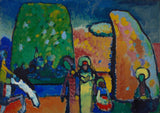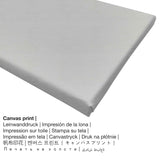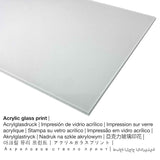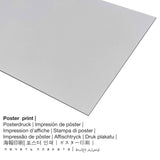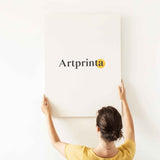Wassily Kandinsky, 1909 - Study for improvisation no. 2 (funeral march) - fine art print
Tax included. Shipping calculated at checkout.
Product specifications
In 1909 Wassily Kandinsky made the 20th century piece of art. The painting had the following size: 49,8 cm x 69,8 cm , 50 cm x 69,5 cm and was painted with the technique oil on cardboard. The original artwork has the following text as inscrption: "1909 Wassily Kandinsky began many of his more important new plants in three categories divide into "impressions," "improvisations" and "compositions". Under "impressions" he understood "impressions of external nature," the "compositions" a deliberate, rational as well as emotional painting, which according to their own laws organized itself (see. Table 29, 30). The group of "improvisation", however, Kandinsky described as "mostly unconscious, mostly suddenly resulting expressions of processes internal character as impressions of the 'inner nature'". The "Study of Improvisation 2 (Funeral March)", whose final version is in the Moderna Museet, Stockholm, is one of the first created and numerous other improvisations that Kandinsky to 1913 numbered in a continuous series. Before an unreal, unreal reminiscent of landscape elements scenery three Russian-looking female characters are at the leading edge gathered in the middle, another sits slightly removed their right, while a rider from coming in left on a white horse in the picture. A touch of symbolism is above the enigmatic scene. As later in a series of "improvisation" characterizes the motive treasure of the fairytale, Russian images even here, despite the formal changes the whole character of this "impression of inner nature." The sub-title designation "Funeral March" indicates less an act but rather the image the mood. In its muted, portentous character, the "Image with Kahn" from 1909 or earlier "Three Women" are roughly comparable, giving in compositional terms as in terms of individual elements clues for the interpretation of "Improvisation 2". Thereafter can the deep blue strip forward as separating the pieces on a ramp identify than water, the two large colored blocks behind them are mountains or cliffs, the round annealed form between them a cloud. But these block-like forms, in particular the right to the bright orange and light blue 'back', seem to turn into organic forms, not least due to the sophisticated color that meets their domestic fields with restless life. In a similarly low-slung stance, the schematic female figures and the on-coming riders from the left remain. is with him appears a central figure of the imagination Kandinsky, often encountered, especially in the group of "improvisation" and not least the symbolic figure of the "Blue Rider" are. All figures are cut off by the edge of the image, which obscures their meaning. Apparently Kandinsky studied in the "improvisations" for anti substantive expressions. The Verunklärungen of form and content are steps on the way to a new, autonomous reality of the painting.". It belongs to the digital art collection of Städtische Galerie im Lenbachhaus und Kunstbau München. This modern art masterpiece, which is in the public domain is included with courtesy of Wassily Kandinsky, Studie zur Improvisation Nr. 2 (Trauermarsch), 1909, Oil On Cardboard, 49,8 cm x 69,8 cm , 50 cm x 69,5 cm, Städtische Galerie im Lenbachhaus und Kunstbau München, https://sammlungonline.lenbachhaus.de/objekt/studie-zur-improvisation-nr-2-trauermarsch-30019275.html. : Städtische Galerie im Lenbachhaus und Kunstbau München. In addition to that, the alignment of the digital reproduction is in landscape format with an image ratio of 1.4 : 1, which implies that the length is 40% longer than the width.
Product materials you can pick
In the product dropdown selection you can pick the size and material of your choice. The following options are available for individualization:
- Printed poster (canvas material): The Artprinta poster is a printed cotton canvas with a granular structure on the surface. The poster print is suited for framing the art print in a customized frame. Please keep in mind, that depending on the size of the poster print we add a white margin of something between 2-6cm round about the work of art in order to facilitate the framing.
- The glossy acrylic glass print (with real glass coating): The print on acrylic glass, which is sometimes referenced as a fine art print on plexiglass, will convert your favorite original work of art into brilliant décor. Your artwork is custom-made with modern UV direct print machines.
- Canvas: A printed canvas, which should not be confused with a canvas painting, is an image printed on a canvas fabric. It makes the unique effect of three dimensionality. Canvas prints are relatively low in weight, which means that it is easy and straightforward to hang the Canvas print without additional wall-mounts. Therefore, canvas prints are suitable for all kinds of walls.
- Aluminium dibond print: Aluminium Dibond prints are metal prints with an impressive depth. The Direct Print on Aluminum Dibond is the perfect introduction to art reproductions on alu. The bright and white parts of the work of art shimmer with a silk gloss, however without any glare. Colors are bright and vivid in the highest definition, details of the print are crisp and clear, and the print has a a matte look that you can literally feel.
Contextual artist metadata
| Name of the artist: | Wassily Kandinsky |
| Nationality: | Russian |
| Jobs: | painter |
| Country of origin: | Russia |
| Artist classification: | modern artist |
| Died at the age of: | 78 years |
| Born: | 1866 |
| Year died: | 1944 |
| Died in (place): | Neuilly-sur-Seine, France |
Background data about the original work of art
| Artpiece name: | "Study for improvisation no. 2 (funeral march)" |
| Categorization: | painting |
| Umbrella term: | modern art |
| Temporal classification: | 20th century |
| Created in: | 1909 |
| Approximate age of artwork: | over 110 years old |
| Medium of original artwork: | oil on cardboard |
| Dimensions of the original artwork: | 49,8 cm x 69,8 cm , 50 cm x 69,5 cm |
| Original artwork inscription: | 1909 Wassily Kandinsky began many of his more important new plants in three categories divide into "impressions," "improvisations" and "compositions". Under "impressions" he understood "impressions of external nature," the "compositions" a deliberate, rational as well as emotional painting, which according to their own laws organized itself (see. Table 29, 30). The group of "improvisation", however, Kandinsky described as "mostly unconscious, mostly suddenly resulting expressions of processes internal character as impressions of the 'inner nature'". The "Study of Improvisation 2 (Funeral March)", whose final version is in the Moderna Museet, Stockholm, is one of the first created and numerous other improvisations that Kandinsky to 1913 numbered in a continuous series. Before an unreal, unreal reminiscent of landscape elements scenery three Russian-looking female characters are at the leading edge gathered in the middle, another sits slightly removed their right, while a rider from coming in left on a white horse in the picture. A touch of symbolism is above the enigmatic scene. As later in a series of "improvisation" characterizes the motive treasure of the fairytale, Russian images even here, despite the formal changes the whole character of this "impression of inner nature." The sub-title designation "Funeral March" indicates less an act but rather the image the mood. In its muted, portentous character, the "Image with Kahn" from 1909 or earlier "Three Women" are roughly comparable, giving in compositional terms as in terms of individual elements clues for the interpretation of "Improvisation 2". Thereafter can the deep blue strip forward as separating the pieces on a ramp identify than water, the two large colored blocks behind them are mountains or cliffs, the round annealed form between them a cloud. But these block-like forms, in particular the right to the bright orange and light blue 'back', seem to turn into organic forms, not least due to the sophisticated color that meets their domestic fields with restless life. In a similarly low-slung stance, the schematic female figures and the on-coming riders from the left remain. is with him appears a central figure of the imagination Kandinsky, often encountered, especially in the group of "improvisation" and not least the symbolic figure of the "Blue Rider" are. All figures are cut off by the edge of the image, which obscures their meaning. Apparently Kandinsky studied in the "improvisations" for anti substantive expressions. The Verunklärungen of form and content are steps on the way to a new, autonomous reality of the painting. |
| Museum / collection: | Städtische Galerie im Lenbachhaus und Kunstbau München |
| Museum location: | Munich, Bavaria, Germany |
| Available under: | www.lenbachhaus.de |
| License: | public domain |
| Courtesy of: | Wassily Kandinsky, Studie zur Improvisation Nr. 2 (Trauermarsch), 1909, Oil On Cardboard, 49,8 cm x 69,8 cm , 50 cm x 69,5 cm, Städtische Galerie im Lenbachhaus und Kunstbau München, https://sammlungonline.lenbachhaus.de/objekt/studie-zur-improvisation-nr-2-trauermarsch-30019275.html |
| Creditline of artwork: | Städtische Galerie im Lenbachhaus und Kunstbau München |
Article background info
| Print prodct: | art copy |
| Reproduction method: | digital reproduction |
| Production process: | UV direct printing |
| Origin of the product: | produced in Germany |
| Type of stock: | on demand |
| Product use: | wall picture, home décor |
| Alignment of the image: | landscape alignment |
| Image aspect ratio: | 1.4 : 1 - length : width |
| Implication: | the length is 40% longer than the width |
| Materials you can choose from: | acrylic glass print (with real glass coating), poster print (canvas paper), metal print (aluminium dibond), canvas print |
| Canvas on stretcher frame (canvas print): | 70x50cm - 28x20" |
| Acrylic glass print (with real glass coating) options: | 70x50cm - 28x20" |
| Poster print (canvas paper) variants: | 70x50cm - 28x20" |
| Dibond print (alumnium material) size options: | 70x50cm - 28x20" |
| Framing of the art copy: | not included |
Disclaimer: We try in order to depict our products as closely as possible and to display them visually. Although, the pigments of the printed materials, as well as the printing can differ slightly from the representation on the monitor. Depending on the screen settings and the condition of the surface, not all color pigments will be printed as realisitcally as the digital version depicted here. Because our are processed and printed manually, there may as well be minor discrepancies in the motif's size and exact position.
© Copyright of - Artprinta (www.artprinta.com)

